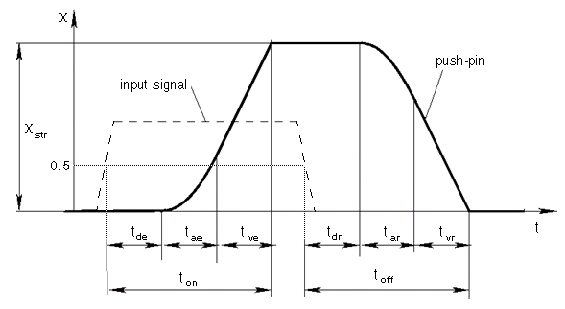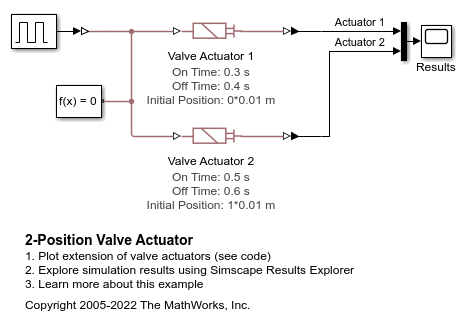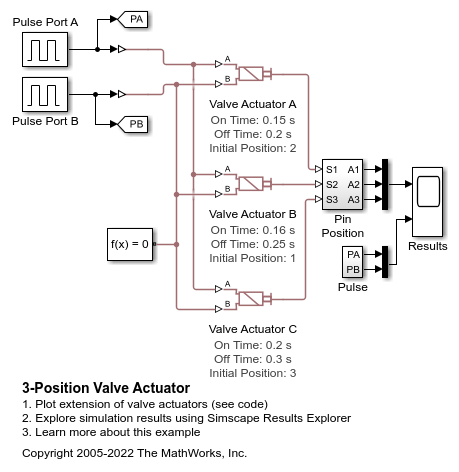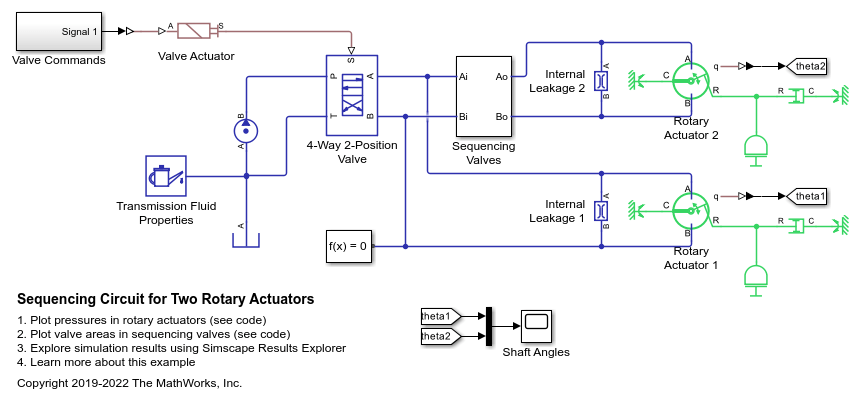Multiposition Valve Actuator
Multiposition actuator in any fluid domain
Libraries:
Simscape /
Fluids /
Valve Actuators
Simscape /
Fluids /
Isothermal Liquid /
Valves & Orifices /
Valve Actuators & Forces /
Valve Actuators
Description
The Multiposition Valve Actuator block models a multiposition actuator in any fluid domain. You can use it in combination with any valve block that takes a physical signal as input. The input signal and the switching time affect the actuator position.
Two-Position Actuator Movement
Actuation begins when the value of the signal at port A exceeds 50% of the value of the Nominal signal value parameter. After a time period that equals one third of the value of the Switching-on time parameter, the actuator begins to move toward the limit specified by the Push-pin stroke parameter.
When the value of the signal at port A falls below 50% of the value of the Nominal signal value parameter, the actuator reverses its direction after a time period that equals one third of the value of the Switching-off time parameter. The motion can be interrupted mid-stroke.

In the image above, ton is the value of the Switching-on time parameter. The actuator motion during ton contains an initial rest, a quadratic motion, and a linear motion, represented by tde, tae, and tve, respectively. tde, tae, and tve are all equal length.
The actuator switches direction when the control signal is off. toff is the value of the Switching-off time parameter, during which the actuator repeats the same stages as the switching-on motion. tdr is a stage of rest, tar is a stage of quadratic motion, and tvr is a stage of linear motion. At the end of toff, the actuator position is at the value of the Initial position parameter. tdr, tar, and tvr are all equal length.
When Actuator positions is 2, the
Actuator travel direction parameter sets the direction of
the push-pin motion.
The actuator motion can be interrupted at any time. If the push-pin motion is disrupted mid-stroke, the switch-on and switch-off times are adjusted proportionally to the push-pin position, relative to the push-pin stroke.
Three-Position Actuator Movement
When Actuator positions is set to
3, the signal at port A moves
the actuator in a positive direction and the signal received at port
B moves the actuator in a negative direction. Only one
signal, from one port, is processed at a time. To switch control between ports
A and B, or between positive and
negative displacement control, the actuator must first move to a neutral position.
If the push-pin motion is disrupted mid-stroke, the switch-on and switch-off times
are adjusted proportionally to the push-pin position, relative to the push-pin
stroke. The actuator motion can be interrupted at any time.
When controlled by the signal at port A, the three-position
actuator has the same displacement profile as the two-position actuator when
Actuator travel direction is set to
Positive. When controlled by the signal at port
B, it has the same profile as the two-position actuator
when Actuator travel direction is set to
Negative.
Examples
Ports
Input
Output
Parameters
Extended Capabilities
Version History
Introduced in R2020a


